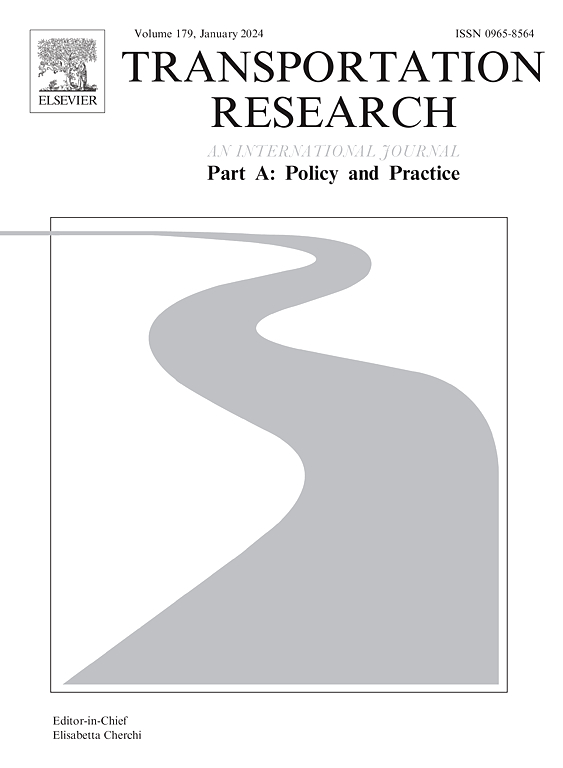Influence factors on travel mode preference of working residents living far away from downtown area on workdays: A hybrid method integrating random parameter logit model and Apriori algorithm
IF 6.3
1区 工程技术
Q1 ECONOMICS
Transportation Research Part A-Policy and Practice
Pub Date : 2024-10-01
DOI:10.1016/j.tra.2024.104275
引用次数: 0
Abstract
This study presents a detailed analysis on the characteristics of travel mode preference of working residents living far away from downtown area on workdays, using GPS-based activity travel diary data from Shangdi area (Beijing). A hybrid method integrating random parameter logit model with systematic heterogeneity (RPL-SH) and Apriori algorithm is put forward to explore the influence factors and interaction effects affecting travel mode preference. First, the RPL-SH model is established to explore significant factors, and capture the unobserved random heterogeneity and systematic heterogeneity due to individual characteristics on the travel mode preference. Then, these significant factors are used to generate association rules by Apriori algorithm to investigate statistical associations between the specific travel mode preference and these significant factors. Ten significant factors are found in the RPL-SH model, in which annual household income is normally distributed. The results of the Apriori algorithm indicate that some factors combined with other factors could significantly influence working residents’ travel mode preference. For example, the combination of lower annual household income and shorter distance between workplace and the nearest bus stop is highly associated with green travel mode preference. Moreover, the results show that the proposed hybrid method not only demonstrates the consistency of the results of the two methods, but also plays a complementary role in exploring more information on travel mode preference. This research hopes to give regulators a better understanding on how working residents living far away from downtown area choose their travel mode, so as to develop more effective and targeted measures for reducing private car use and alleviating workday traffic congestion.
远离市区的工作居民工作日出行方式偏好的影响因素:随机参数 Logit 模型与 Apriori 算法的混合方法
本研究利用北京上地地区基于 GPS 的活动出行日记数据,详细分析了远离市区的上班族工作日出行方式偏好的特征。本文提出了具有系统异质性的随机参数 Logit 模型(RPL-SH)和 Apriori 算法相结合的混合方法,以探讨影响出行方式偏好的影响因素和交互效应。首先,建立 RPL-SH 模型来探索重要因素,并捕捉个体特征对出行方式偏好的未观测随机异质性和系统异质性。然后,利用 Apriori 算法生成关联规则,研究特定出行方式偏好与这些重要因素之间的统计关联。在家庭年收入呈正态分布的 RPL-SH 模型中发现了 10 个重要因素。Apriori 算法的结果表明,一些因素与其他因素的结合会显著影响工作居民的出行方式偏好。例如,较低的家庭年收入和工作地点与最近公交站点之间较短的距离这两个因素的组合与绿色出行方式偏好高度相关。此外,研究结果表明,所提出的混合方法不仅证明了两种方法结果的一致性,而且在探索更多出行方式偏好信息方面起到了补充作用。这项研究希望能让监管部门更好地了解远离市中心的上班族是如何选择出行方式的,从而制定出更有效、更有针对性的措施,减少私家车的使用,缓解工作日的交通拥堵。
本文章由计算机程序翻译,如有差异,请以英文原文为准。
求助全文
约1分钟内获得全文
求助全文
来源期刊
CiteScore
13.20
自引率
7.80%
发文量
257
审稿时长
9.8 months
期刊介绍:
Transportation Research: Part A contains papers of general interest in all passenger and freight transportation modes: policy analysis, formulation and evaluation; planning; interaction with the political, socioeconomic and physical environment; design, management and evaluation of transportation systems. Topics are approached from any discipline or perspective: economics, engineering, sociology, psychology, etc. Case studies, survey and expository papers are included, as are articles which contribute to unification of the field, or to an understanding of the comparative aspects of different systems. Papers which assess the scope for technological innovation within a social or political framework are also published. The journal is international, and places equal emphasis on the problems of industrialized and non-industrialized regions.
Part A''s aims and scope are complementary to Transportation Research Part B: Methodological, Part C: Emerging Technologies and Part D: Transport and Environment. Part E: Logistics and Transportation Review. Part F: Traffic Psychology and Behaviour. The complete set forms the most cohesive and comprehensive reference of current research in transportation science.

 求助内容:
求助内容: 应助结果提醒方式:
应助结果提醒方式:


